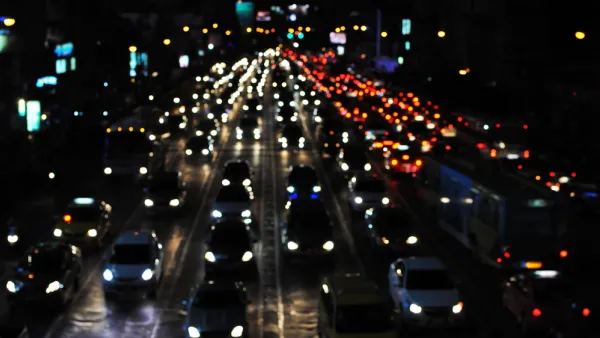Faced with paralyzing gridlock, North America's fourth-largest city is studying several potential solutions for easing congestion - including traffic lights that think for themselves.
Oliver Moore looks at some of the potential solutions, technical and behavioral, for easing Toronto's $6-billion gridlock problem, which is among the worst in North America. One such solution is University of Toronto professor Baher Abdulhai’s intelligent traffic light project, which "marries cameras with computers to create traffic lights that can measure vehicle flow, understand what it means, and adapt signal patterns to reduce gridlock."
"Of course, traffic isn’t all bad," adds Moore. “Some congestion is a sign of vibrancy,” says Prof. Abdulhai in the draft of an upcoming report for the Residential and Civil Construction Alliance of Ontario, “but too [much] congestion has many negative consequences. … The good news is that there are plenty of approaches to address congestion, traditional and non-traditional, technical and non-technical.”
"No major city is free from traffic problems, and urban planners say that the situation, while frustrating, is a sign of a healthy community," says Moore. "So along with all the congestion-busting ideas, the necessary final ingredient may be a different public attitude – a change in what we consider acceptable."
FULL STORY: Unlocking the gridlock

National Parks Layoffs Will Cause Communities to Lose Billions
Thousands of essential park workers were laid off this week, just before the busy spring break season.

Retro-silient?: America’s First “Eco-burb,” The Woodlands Turns 50
A master-planned community north of Houston offers lessons on green infrastructure and resilient design, but falls short of its founder’s lofty affordability and walkability goals.

Delivering for America Plan Will Downgrade Mail Service in at Least 49.5 Percent of Zip Codes
Republican and Democrat lawmakers criticize the plan for its disproportionate negative impact on rural communities.

Test News Post 1
This is a summary

Test News Headline 46
Test for the image on the front page.

Balancing Bombs and Butterflies: How the National Guard Protects a Rare Species
The National Guard at Fort Indiantown Gap uses GIS technology and land management strategies to balance military training with conservation efforts, ensuring the survival of the rare eastern regal fritillary butterfly.
Urban Design for Planners 1: Software Tools
This six-course series explores essential urban design concepts using open source software and equips planners with the tools they need to participate fully in the urban design process.
Planning for Universal Design
Learn the tools for implementing Universal Design in planning regulations.
EMC Planning Group, Inc.
Planetizen
Planetizen
Mpact (formerly Rail~Volution)
Great Falls Development Authority, Inc.
HUDs Office of Policy Development and Research
NYU Wagner Graduate School of Public Service



























